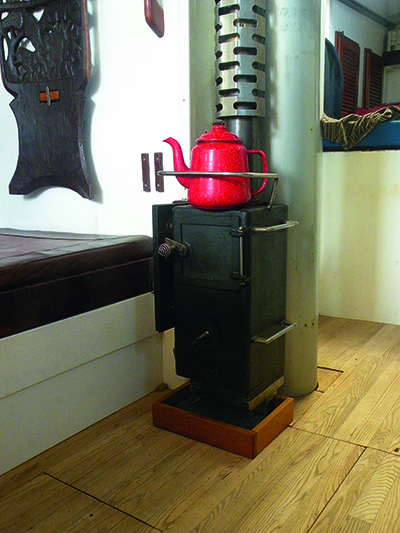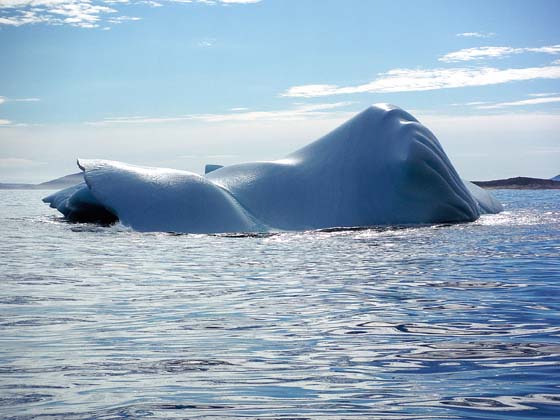On an eastward crossing of the North Atlantic solo sailor Trevor Robertson dodged Hurricane Bertha and encountered Cristobal in his gaff cutter Iron Bark. Then on the way back it was icebergs …
Winter in Stornoway
Iron Bark and I spent most of the following winter in Stornoway on the Isle of Lewis. Stornoway’s inhabitants are reputed to be dour religious fanatics who speak only Gaelic, but I found them to be hospitable and outgoing and the music excellent.

Cragaig Bay, Ulva, off Isle of Mull
In April 2015 I left Lewis and meandered south through the Hebrides to Rathlin Island on the Northern Irish coast. Rathlin, like Stornoway, needs time to be appreciated. Again I found it friendly with good music, and it has an engaging and peculiarly Irish eccentricity. I spent three pleasant weeks there.
My next destination was Labrador. Ocean Passages for the World, which I consult religiously before every passage (my elderly copy looks like a Bible), is not encouraging about a westbound summer voyage across the North Atlantic. The southern route in the Trades is likely to run into a hurricane; the direct passage against both wind and current is ‘seldom possible for a sailing vessel’; the northern route (north of 55°N) not recommended except in autumn because of the prevalence of ice and bad weather. The northern route is the obvious option if bound for Labrador, but I did not expect it to be easy.

A ceilidh in Rathlin
After waiting out a series of westerly gales, I sailed from Rathlin on 8 June 2015 with a high pressure system over Britain that I hoped would bring moderate north-east winds. It brought only an extended calm and I took three days to drift 120 miles to the edge of the continental shelf. It was calm there too, with fulmars paddling laps around us, but we were clear of fishing boats and I could sleep.
After another two days becalmed, a moderate northerly carried us 150 miles clear of Ireland’s west coast. It had taken a week, but we finally had enough sea room to ride out a gale.
Over the next week we made slow, steady progress close-hauled in moderate to fresh headwinds, with time lost to a south-westerly gale. It only blew for half a day, but I left Barky hove to for 33 hours, reckoning it not worth the discomfort and wear on the gear to drive her into wind and sea in a near-gale.
An escort of fulmars
We lay under deep-reefed mainsail with our escort of fulmars paddling companionably in the slick Iron Bark left as she drifted slowly across the wind. A few days later there was a short-lived gale from the south-east, a fair wind, and we ran before it under bare poles. Neither of these gales was more than an inconvenience and we had ample sea room to ride them out.
In the week following we had a mixed bag of wind, more fair than foul to my surprise and gratification, and made good 636 miles. What little current there was seemed to be favourable. It was cold and brought fog and low overcast that left the cabin dank and my bedding damp. They stayed that way for the rest of the passage as I do not light the heater at sea and anyway there was only half a bag of peat left in the fuel bin.

There were pilot whales about, often accompanied by common dolphins, to brighten the dull days. The pilot whales ploughed along sedately behind Iron Bark while the dolphins zigzagged ahead, their chirping coming clearly through the hull.
On 26 July, 600 miles east of Labrador, we crossed the line on the chart marking the extreme limit of icebergs. Generally there is little ice this far east and the odds of hitting it only become significant when close to the Labrador coast. I continued to sail into the fog with only a desultory lookout by day and none at night, but radar would have been a comfort.
Current eddies 200 miles off the Labrador coast marked where the Labrador Current meets the continental rise. These upwellings must be nutrient-rich judging by the number of birds there: fulmars, great shearwaters, gannets and terns and a few storm petrels.
Visibility less than a cable
On 30 June, about 75 miles offshore and 130 miles from my intended landfall of Makkovik Bay, the fog lifted briefly revealing an iceberg a couple of miles off. From then on I kept a proper lookout. As the visibility was often less than a cable, this meant standing in the hatch staring into the murk with no break for more than a minute. That night for the first time I hove-to for fear of hitting ice.
Iron Bark forereaches at about a knot when hove-to so there is still a chance of hitting something, but the low speed reduces the danger of a collision. The next day was again foggy and I kept a constant watch as we sailed into the mank. I saw only six bergs, but as the visibility varied from a cable to a mile, did not take this to indicate that ice was scarce.
My destination was Strawberry Harbour, an uninhabited cove at the mouth of Makkovik Bay. There is no detailed chart of Strawberry Harbour, but I had a sketch plan drawn on a previous visit to Labrador. Its entrance is about half a cable wide with a dogleg and is not one to attempt in the dark. The harbour itself is well protected with good holding, but restricted swinging room.
About 25 miles short it was obvious that I could not make it before dark so hove-to for the night under deep-reefed mainsail. Within an hour the south-east wind had increased from Force 6 to Force 8 with a falling barometer. The poorly charted, rocky, fog-shrouded coast was only 15 miles away, too close for safety if this gale should back two points. We needed more sea room so I spent a very cold half hour bending on the storm staysail.
We charged off towards deep water as soon as I let the staysail draw with the wind, now south-east Force 9, just forward of the beam. The gear was straining and we were sailing too fast for safety in poor visibility, but it was better than being jammed against the coast.
At dusk three hours later with 30 miles of sea room and visibility fading, I prepared to heave-to again. At that point a large iceberg with a train of bergy bits appeared out of the murk. Parking near that lot was not an option so I crashed blindly into the darkness for another hour.

Five miles from the berg I hove-to and went below. The temperature in the cabin was 2°C, but it was a haven of warmth and quiet compared with the cockpit. Keeping watch was pointless as visibility was nil so I turned in fully dressed. If we drifted onto ice there would be no time to pull on boots.
Fog and ice offshore
By morning the wind had eased to south-east 7 with visibility of one to two miles and no ice in sight. Closing the coast in those conditions had no appeal so I remained hove-to. The improved visibility meant I could cower below, poking my head out to look around every half hour. Next morning, 4 July, after 36 hours hove-to, I let draw with reefed mainsail and working staysail and made for Strawberry Harbour, now 62 miles south-west.
The wind was south-east Force 6 with fog banks. Several times during the day I had to jink violently to avoid ice that loomed out of the murk. As we closed the coast the wind increased to gale force and the fog thinned. I deep reefed the mainsail and when an island two miles off Strawberry Harbour gave a little protection, handed it and closed the harbour under staysail and motor.
The entrance looked horrible, but the fog and ice offshore looked worse so I dropped the staysail and went in under engine. At times the motor was barely able to hold Iron Bark’s head into the wind as we crept in against gusts of Force 10 that shrieked down from the hills.
I let the anchor go on the minimum scope I thought possible in that wind. Although it held the wind sent us sheering dangerously close to the rocky shores. I did not dare reduce the scope so, as quickly as I knew how, stocked and set a second anchor. Then, using brief lulls, I launched the dinghy and rowed a warp with a chain sling to the shore.
We were secure in the middle of the harbour despite the gusts rocketing down the hillsides. I went below and lit the heater using the last of the Irish turf.
The passage had taken 26 days. It was straightforward enough until the last three days, but those days made up for the earlier ease. Ice, fog and a rocky shore are a nasty combination at any time; they terrify me in a gale.




